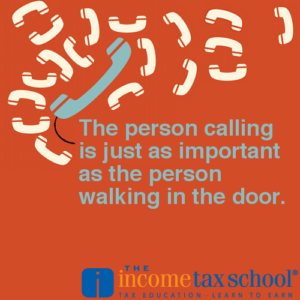 There’s a customer service motto that goes like this: The person calling you on the phone is just as important as the person who walks in the front door. There’s really no difference between the two. Yes, the people walking in the door most likely have appointments, but doesn’t that make the person calling much more important? The person calling could be a potential new client looking for information or ready to schedule their tax prep interview.
There’s a customer service motto that goes like this: The person calling you on the phone is just as important as the person who walks in the front door. There’s really no difference between the two. Yes, the people walking in the door most likely have appointments, but doesn’t that make the person calling much more important? The person calling could be a potential new client looking for information or ready to schedule their tax prep interview.
It’s important for a tax office to have a telephone answering policy – one that everyone in the office knows and complies with regardless of whether or not you have a receptionist. Here are some best practices you should consider including in your policy.
Answer the phone within two rings
You wouldn’t leave a walk-in waiting at the door so don’t let the phone ring waiting for someone else to pick it up. Two rings is a standard customer service practice. A ringing phone is a distraction to others in the office. If you anticipate there being of question of who should pick up the phone, create a telephone answering chain that starts with the receptionist. If for some reason she is away from her desk, there should be a second person assigned to answer the phone. If that person is gone, there should be a third person, and so on. If you don’t have a receptionist you could ask your staff to take turns. Whatever you decide to do, have a policy in place so that when the phone rings, there is no question who should answer it.
Multiple locations. One phone number.
At Peoples Tax, we put one central number on all of our marketing materials as to not confuse people looking for information. The phone rings at the corporate office where a receptionist answers and then transfers the caller to the location nearest them.
This enables Peoples Tax to handle calls more efficiently and professionally while also reducing telephone interruptions of Tax Associates conducting interviews.
Smile when you talk
If you want to relay a positive and pleasant tone, smile when you talk – your smile comes through. Believe it or not, being annoyed and making faces of disgust or displeasure come through the phone. So smile!
The Greeting
Your greeting should go like this.
An actual greeting: Good morning, good afternoon, having a great day…
The name of your company.
The name of the telephone answerer.
How may I help you?
Put together, a greeting might go like this: “Having a great day at Peoples’ Tax, this is Chuck, how may I help you?”
Listen and be empathetic
There’s a reason the person on the other end of the phone is calling. Listen for it. Listening is an important customer service skill to have because many times you will need to read between the lines in order to get to the root of the problem. Listening means not interrupting the person explaining the problem, or the information they need.
If there is a problem, empathy is the best way to approach it. Listen, and then empathize with the person. “I’m so sorry you’re experiencing a problem with X.”“Wow that’s frustrating. Let me see what I can do to help.”
Customer service situations are quickly escalated when the customer feels that the employee is not listening, doesn’t care, or both.
Own the problem
If there is a problem, the person who answered the phone should own it no matter what the problem is. This means that they are to see that the person who called gets the information or resolution they need. Passing it off to the next person is not seeing the problem through.
Know your policies and promotions
There’s nothing more frustrating as a client than calling to get more information only to find that the person on the other end has no idea what you’re talking about. Everyone who answers the phone should know what the current promotions are. They should also know what the policies are behind redeeming those promotions.
Don’t leave them hanging
Sitting on hold is the worst. If you have to put someone on hold to transfer to another associate, ask if you can take a message or have that person call them back if you see they are busy with another client. Never ask the person to call back. Also, make sure that your promise to have their call returned is kept.
In the event that you do need to call someone back, be sure to call back within 24 hours – even if it’s to update them that you are still working on obtaining the information they need.
Do you follow these best practices? Are they included in your Policies and Procedures Manual? We’d love to hear from you!
If your office does not have a Policies and Procedures Manual, don’t reinvent the wheel. Purchase our Tax Office Operations Manual.
More Great Reads:
Addressing Tax Service Problems
